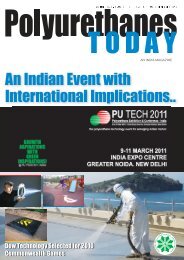Today - Polyurethane Association of India
Today - Polyurethane Association of India
Today - Polyurethane Association of India
You also want an ePaper? Increase the reach of your titles
YUMPU automatically turns print PDFs into web optimized ePapers that Google loves.
PU<br />
<strong>Today</strong><br />
Technical Article<br />
foaming station, thus requiring an<br />
almost automatic adjustment <strong>of</strong> the<br />
jig’s walls, to be performed quickly.<br />
The foaming concept had to be rethought,<br />
as well as the design <strong>of</strong> the<br />
required tool.<br />
The same approach had to be followed<br />
for the chemical side, for the very good<br />
reason that a major change in foaming<br />
technology would not be adopted by<br />
the appliance manufacturers if the<br />
obtained savings were not more than<br />
substantial in terms <strong>of</strong> foam’s lambda<br />
value, demolding time and molded<br />
density. Here, too, a major amount<br />
<strong>of</strong> R&D work was demanded to the<br />
chemical specialists.<br />
The V.A.I. Project<br />
Cannon approached this project<br />
– named V.A.I. (Vacuum Assisted<br />
Injection) – using the human, financial<br />
and technical resources available<br />
in their two Divisions involved in<br />
refrigerators manufacturing: Cannon<br />
Afros for the metering and mixing<br />
equipment, and Cannon Crios for the<br />
cabinet’s polymerization and handling<br />
solutions. A team <strong>of</strong> specialists<br />
identified a number <strong>of</strong> technical<br />
problems, and soon started to suggest<br />
various hypothetically viable solutions,<br />
to be ground tested in Cannon R&D<br />
laboratories. The development work<br />
took several months.<br />
After a number <strong>of</strong> unsuccessful<br />
attempts with available formulations<br />
modified on purpose, a new,<br />
dedicated chemistry was developed<br />
by Dow. Cannon in the meantime<br />
designed the first industrial solution<br />
for the production jig.<br />
The V.A.I. Jig construction<br />
The new jig has the same functionality<br />
and movements <strong>of</strong> a standard jig but<br />
28 p o l y u r e t h a n e s t o d a y<br />
its lateral sides, the upper plate<br />
which holds the plug and the top and<br />
bottom walls are fitted with special<br />
seals that, when the jig is locked,<br />
provide an airtight cavity (Picture 6).<br />
The vacuum is applied through the<br />
upper plate. The main difference<br />
Picture 6 – The Cannon V.A.I. foaming jig<br />
with a standard polymerization jig<br />
is the use <strong>of</strong> a sliding plate, called<br />
pallet, where the back wall <strong>of</strong> the<br />
fridge rests. This pallet is sliding in<br />
and out from the jig for the cabinet’s<br />
loading and unloading operations.<br />
It is not recirculated around the<br />
plant and thus can be permanently<br />
connected to a hot water circuit for a<br />
very efficient thermostatization.<br />
The V.A.I. module:<br />
Productivity/investment<br />
optimization<br />
An industrial foaming plant based<br />
on V.A.I. jig is typically composed <strong>of</strong><br />
eight jigs placed side-by-side, each <strong>of</strong><br />
them served by one loading and one<br />
unloading conveyor (Picture 7). The<br />
two automatic devices travel above<br />
these conveyors: the loader picks the<br />
empty, warm cabinet coming from<br />
Picture 7 – A typical foaming plant with<br />
eight Cannon V.A.I. foaming jigs<br />
the pre-heating oven (on the far right<br />
<strong>of</strong> the plant) and carries it towards<br />
the jig that has produced the latest<br />
cured cabinet. The unloader picks it<br />
from the pallet where it is carried,<br />
and moves to the left <strong>of</strong> the plant to<br />
the discharge area. In the meantime<br />
the loader moves right over the pallet<br />
and unloads on it the empty cabinet,<br />
which immediately is brought in<br />
the waiting jig. The cycle starts, as<br />
described before. Productivity <strong>of</strong><br />
this configuration can be up to two<br />
cabinets per minute.<br />
V.A.I. – Main Advantages<br />
Several innovative features provide a<br />
number <strong>of</strong> interesting advantages:<br />
l Faster demolding time, up to 50%<br />
less than with conventional foams<br />
l The system is suitable for difficult<br />
cabinet geometries: even the<br />
combined use <strong>of</strong> VIP (Vacuum<br />
Insulated Panels) is possible, since<br />
the foam filling operation is much<br />
easier than with a slow, conventional<br />
formulation.<br />
l k-factor values <strong>of</strong> the foamed<br />
refrigerators are very low, due to the<br />
finer cell structure and the very even<br />
distribution <strong>of</strong> densities across the<br />
entire cabinet.<br />
The Rotojig Development<br />
In order to reduce the service time<br />
to get full advantage <strong>of</strong> this new<br />
fast curing formulation, Cannon<br />
developed a new solution for the<br />
d e c e m b e r 2 0 1 1












